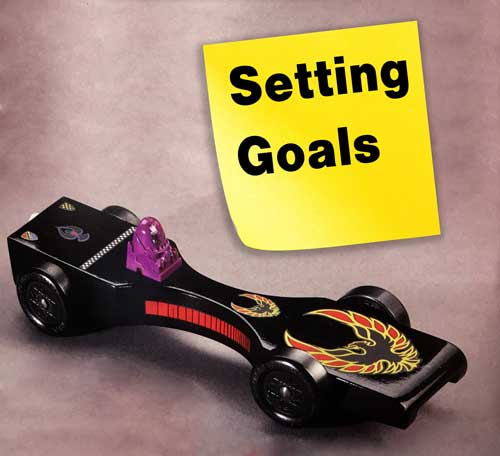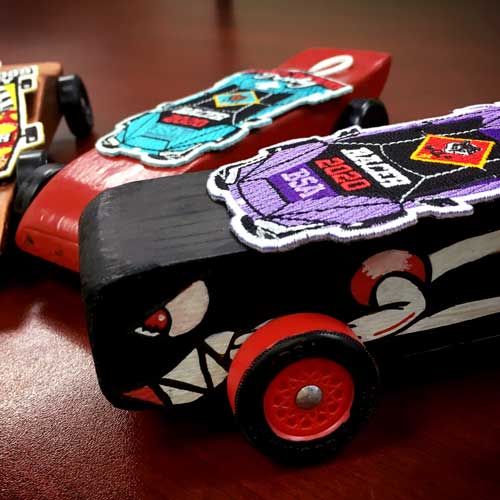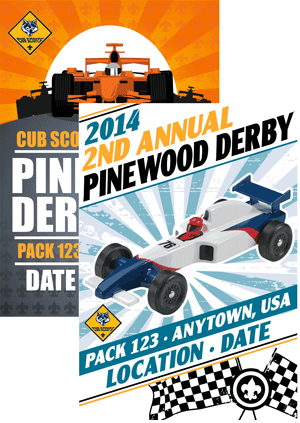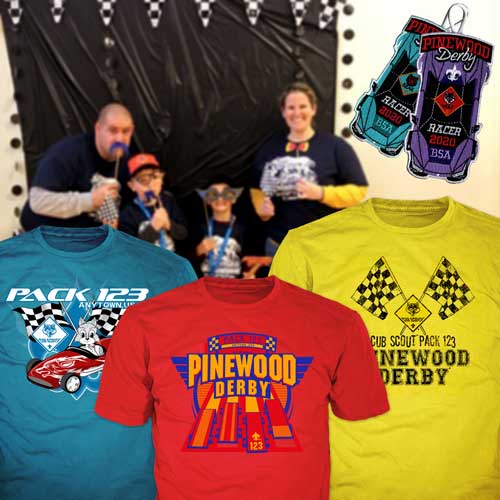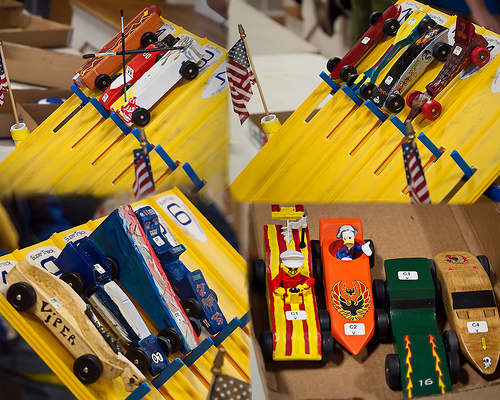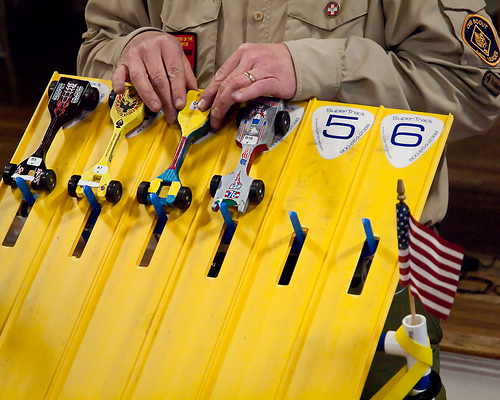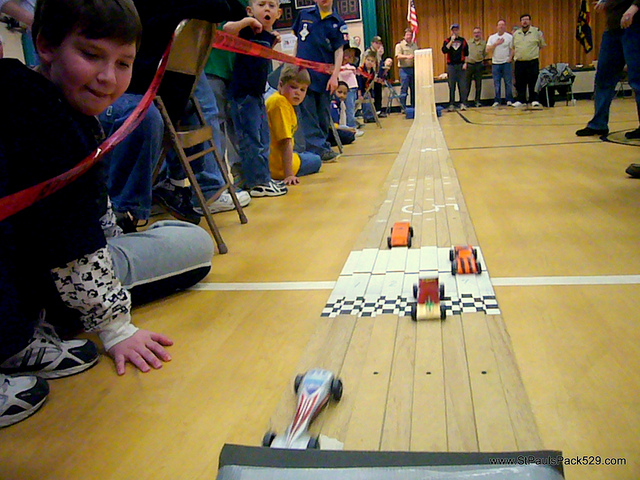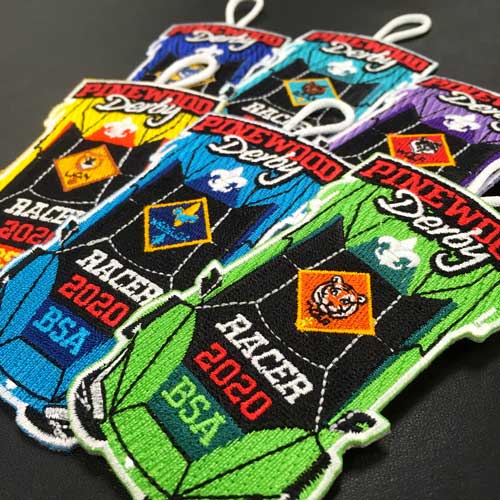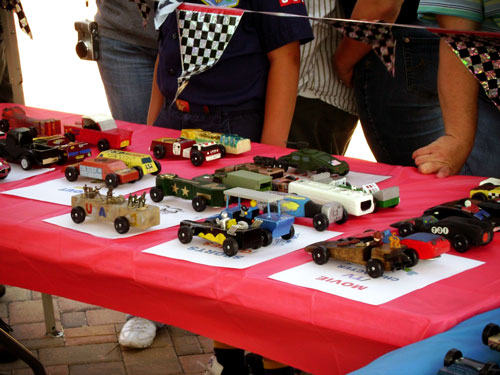
Download Pinewood Made Easy PDF
Introduction
The Derby is a part of the Scouting program that seems to draw more controversy than all other parts of the typical pack’s annual program put together. Even worse, if a particular pack has problems one year, those tend to snowball from year to year and draw out the less attractive elements of our character, to put it kindly. I have lost count of how many times I have heard or read some one say “I hate pinewood derby!”
There’s different things packs do to try and solve the recurring problems:
Unfair judging? Remove the judge.
There is an entire industry that caters to the idea that in order to determine the fastest of two blocks of wood with nail axles and plastic wheels, you must have a computer, machined high tech track, software to run endless round robin races, and laser guided smart timers accurate to 1/100,000 of a second with GPS Positioning accurate to 1 nanometer.
Parental overinvolvement? Remove the parents.
We see packs that sequester the boys in secret workshops with no parents allowed so that every block of wood is 100% boy carved and none are tainted by the unfair influence of a parent with greater skills or interest than any other parent.
Always stuck in the “slow lane?” Remove all chance.
We have packs that race every single car against every other single car on every single lane twice so that there can be no complaints about a “fast lane” or a “slow lane” or a bad start. Some packs boast that they can hold a race every 45 seconds. Can you imagine hundreds of races going so fast nobody can figure out what is happening?
It doesn’t have to be this way!
It can be fun, challenging, and interesting. You can have a great time and the boys can have a great time!
This book is about using the Pinewood Derby as another part of the
greater program and vision of scouting. It is a wonderful tool to teach
sportsmanship and having respect for other people. It offers a fine way to help
parents and cubs bond and work together to achieve a common goal and hopefully make it clear that every scout can come away from the pinewood derby a winner.
Every scout, parent, friend and supporter of the pack will leave the race excited about next year’s Pinewood Derby!
Chapter 1. Setting Goals
In most information you find the purposes of Cub Scouting are usually listed as:
- Character Development and Spiritual Growth
- Character Development and Spiritual Growth
- Good Citizenship
- Sportsmanship and Fitness
- Family Understanding
- Respectful Relationships
- Personal Achievement
- Friendly Service
- Fun and Adventure
- Preparation for Boy Scout
It is simplistic perhaps to think that EVERY activity, meeting, and event should used to accomplish one or more of the purposes of Cub Scouting. However, if you make that your goal, the purposes become a glue that can bind an entire year together. Read the list and begin to formulate how any particular activity can be used to promote one or more of these concepts. Let’s apply this to the Pinewood Derby Race and see what fits:
- Character Development: Following the rules and playing fair.
- Sportsmanship: Learning to win AND lose with grace.
- Family Understanding: The parent and cub working together and sharing in the results.
- Personal Achievement: Learning skills about building the racer.
- Fun and Adventure: What better way to describe a day at the races!
Now that we know how a derby can fit into the larger program, we can then develop a unique set of goals for our particular event. Here is a set of goals that a pack might adopt for its pinewood derby:
- 1. Develop a set of rules for all to follow.
- 2. Hold a competition that allows scouts to experience winning and losing.
- 3. Encourage and enable interaction between parent and cub.
- 4. Recognize every Scout for achievement.
- 5. Provide lots of fun for every attendee.
Certainly,
each pack should develop its own set of goals. Develop your own and be sure to keep them in
general terms. As we develop our plan, we will test everything that we are doing against our list of goals and make sure that it meets or exceeds the expectation.
Chapter 2. Getting Started
The most exciting Pinewood Derbies require lots of planning and lots of volunteers to help with the event. It seems the best way to do this is with a Pinewood Derby committee. I suggest organizing a committee at the first pack meeting of the year and “drafting” as many parents as possible to help. Starting with a show of hands of “How many parents have seen a Pinewood Derby before?” will get you lots of help if you follow it with, “ How about a round of applause for this year’s Pinewood Derby committee!” I would then have them see you immediately after the meeting.
I usually use a sign up sheet to fill the different positions (see appendix for a
sample pinewood derby committee sign-up sheet) and fill all the main spots that night. I also gather a list of names and phone numbers for people who may not be able to fill a key slot but would be glad to help. These people are assigned to each chairperson as required. The basic jobs that need to be filled are:
- Chairman: Responsible for the overall event.
- Assistant Chair: assists the chair person and coordinates all “Day of” events.
- Rules: Produces and distributes the rules and tips for the Pinewood Derby.
- Track: Responsible for setup and tear down of the race track.
- Publicity and Fundraising: Promotes the event in the pack and the community and solicits sponsors to underwrite the cost of the event.
- Concessions and Diversions: coordinates food and drink sales, gathering, and between-race activities and games on race day.
- Race Operations: Responsible for arranging and supervising the races including handling of cars after check in, starting, judging, reporting of winners, and car handling.
- Race Announcer: Handles the announcing of heats, group communication, crowd control, etc. on race day.
- Set Up and Clean Up: Supervises the “before and after of the racing area”.
Once you have your committee you should hold a meeting and coordinate with each person exactly what duties they will have. In the Appendix you will find a timeline for a Pinewood Derby Race and most of the planning stages fall clearly into one person’s area of responsibility. At your first meeting you should also establish when and where you will hold the next meeting, a process for reporting progress, and address any concerns at that time. I suggest you give each person a series of dates that certain parts of their task needs to be complete. This will help everyone stay on track (no pun intended) and get the race ready to go on time.
Chapter 3. Rules
Why are rules necessary? Since one of our goals is character development and learning to follow the rules, we need a complete set of rules governing all aspects of the race. Many times I have seen a pack that has a written set of rules that is ONLY the piece of paper that comes in the box with the car kit. This is like the NFL holding a super bowl with the only rules being about the size and shape of the ball! It would sure make for an interesting game just like that piece of paper as the only rules makes for an interesting Pinewood Derby.
Here are some of the basic considerations that need to be covered by a set of rules:
- A. Who is eligible to race
- B. Car size, weight, dimensions
- C. Inspection and what to do if a car doesn’t pass inspection
- D. How to determine a winner
- E. Track failure, car failure, judges error
- F. How winners will be recognized
- G. Design contest categories and criteria
There are many sets of rules which are publicly available on the internet and you may want to ask at your roundtable if other packs have a set of rules they’ve had success using. I have also included some
sample pinewood derby rules in the appendix. The rules committee should begin early and draft a set of rules that will help achieve the goals as listed. The key to the success of the rules is to distribute them to everyone
before they build the cars. Be sure to have extra sets on hand for the judges and for race day.
Chapter 4. Publicity and Fundraising
Communication is the key to a every successful event. Not only do the members of the pack need to know what is going on, but so does the community. Successful events involve many different people and getting different people all working together requires successful communication. In general, there are four different areas that need to be addressed, publicity, pack promotion, sponsors and benefactors, and judges. All of this falls under the Publicity and Fundraising chair’s area of responsibility. Lets look at these four areas one at a time.
Publicity is one of the first orders of business. We must garner as much public attention as soon as we can. If the general public knows the event is coming, this will make it easier to obtain “celebrity” judges, award sponsors, and can even bring in more boys and leaders! I suggest starting publicity as early as 4 months before the event.
If you haven’t already developed a relationship with your local newspaper, now is the time to start! A press release about the “New” derby being planned for the pack would be appropriate at this time. Cover the fact that there is a design contest with experts in design judging and sponsors for awards. Once this is published you can mine some sponsors and judges from it. Who doesn’t want to be considered an expert in their field? Follow this up with a news release announcing the final panel of judges and a different release proudly announcing the sponsors for this years race. As soon as the kits are distributed, announce the number of participants and when and where the race will be held. After the event is over, a final article thanking everyone and announcing the winners will finish off a successful publicity campaign.
Second comes pack promotion. This also needs to be started early. About 3 meetings before the derby, send home an announcement about the derby. This announcement should include the goals of the pinewood derby, when and where the car kits will be distributed, that rules and tips will be distributed with the car kits, and solicit any questions anyone may have. Follow up at the next meeting with a reminder when the cars will be distributed. Inform the pack when sponsors and judges have been secured. The single most important part of a successful stress free derby is fully and repeatedly getting the
goals and rules across to the boys and their parents.
Sponsors have a different set of information requirements. Here we contact them early with an approximate cost for sponsorship and the benefits that they can accrue from being a part of this event. I suggest a 1 page information sheet listing the total number of boys, the number of families and the amount of publicity to be generated. Also list what additional benefits available for the sponsors. Benefits might be that they can be a judge, bring products to show at the event, put up their corporate banner, or whatever. Picture this event–the race area is covered with sponsor banners so that it looks just like the Indy 500. Outside, a local car dealer who has sponsored has brought several cars to show while the races are going on. The concession stand is fully paid for by the local bottling company who also has their mascot at the event. The entire race, from awards to kits, is being paid for by the sponsors. This is totally possible and will further enhance the experience for the boys. Imagine how they feel as they walk to the sign in table past the brand new Ford Mustang the dealer has brought in for the Derby!
Judges are the fourth area of communications requirements. Here it is a two step program –
recruiting and
confirming. Begin with a simple 1 page flyer describing when, where, and why about the judging. Stress that training will be provided, and that the pack is seeking high profile judges to set an example for the boys. Use this flyer as a recruiting tool to gather your judges.
Remember that in addition to the main judges for who wins the race and who wins the design contests, that you will need a starter, registrar, and 3-4 people at the beginning to inspect and qualify all the cars.
There are many ways to accomplish this but I have found, over and over, that
people NOT directly involved in the pack make the best choice. Use prominent figures for guest judges for the design contest and judging the finish line and invite senior members of your local Boy Scout troop to do the weigh in, measuring, and visual inspection before the race. The Troop’s SPL makes an excellent starter and the scouts who were officials at the beginning can be put to work moving cars from the finish line to the staging area.
Sponsors and judges often require personal visits to secure the participation your pack would like. This is as much salesmanship as anything else and is beyond the scope of this book. I consider fundraising to be a vital part of a truly successful derby and can move it from just another pack meeting to an amazing event of epic proportions! When you recruit for your committee, look for someone who has contact and experience with a variety of business people.
In our small town, every car dealer sponsors events at costs from $500 to $1000 where the total attendance might be under 100 people. I think that car dealers and others in the automotive industry (like auto parts, repair shops, and even the local race track) should definitely be approached for this event. Its a natural tie in and they will have exposure to families who will always need a new car or work done. It is a perfect fit and can really make your event successful.
Another fundraising opportunity occurs on the day of the event. I have talked to several packs who operate concessions during the race. In one case, they had decided to let the local High School band operate the concession stand and split the profits because they were generating “way more money than they needed!” I was surprised at how many packs sold hot dogs and chips and
paid for all the awards for the derby with that money.
Chapter 5. Concessions and Diversions
In the previous chapter we talked about the fundraising aspects of a concession stand at the event. With the understanding that each situation is different and local rules may apply, here are some suggestions.
-
• Determine how long the event will take. Using Robert’s Rules of Silly Guesses #3 you simply multiply the number of participants by 4 and add 30 to the results. This will return, in minutes, how long the event itself will take. Setup and tear down not included. In the case of a pack with 30 boys – figure 2 1/2 hours from when you open the check-in process until the final award has been presented. (Your results may vary, it depends on how fast the Master of Ceremonies talks!) Depending on the length of time you expect for the event and the start time, determine if you are operating during a meal period, between meal periods, or across two meal periods. If you are expecting a four hour event starting at 9 AM you can offer breakfast and lunch!
-
• Determine the menu and then guess at how much of everything you need. Robert’s Rules of Silly Guesses #5 tells us that you can never be sure of what you need so it is better to buy small containers and open them as necessary rather than the monster-mega sizes and have 54 1/2 gallons of sauerkraut left over! (Based on a true story! There was also 15 pounds of relish and seemed like a million pickles but it “sure seemed like a good idea” at the wholesale discount warehouse. I think the sauerkraut was eventually used to recover several miles of trails in the woods.) Price may also determine consumption. Don’t overlook snack items like candy or chips, fruit, drinks, and desserts. Have a plan to sell any left over bulk items that can’t be returned at the end of the event.
-
• Don’t overlook opportunities in food service sponsorships. Drinks can often be donated or the free use of a “drink trailer” can be arranged. One year we arranged for a local packing house to donate 300 hot dogs! This will greatly reduce your costs, increase your profits, and provide increased exposure for the sponsor.
-
• Diversions are important for the “dead air” time you’ll have between the races of different ranks. While it’s guaranteed all your cubs will be excited about the webelos races (because they’re the cool older kids), you will see wondering attention spans during the younger scouts races. It’s also important to have activities for the younger siblings and friends of your cubs. Consider some of these suggestions: show racing movies, have a coloring contest based on race cars, make a craft related to racing, Kim’s game relating to racing, “Thank You” poster(s) signed by all the pack members and friends to present to the sponsors, judges, and so forth.
Chapter 6. Getting Ready for Race Day
This chapter deals with the variety of details that must be addressed before the derby can take place. These ideas should make the actual race day go very smoothly.
Distribution of Car Kits
Kits can be distributed to the boys in a number of different ways. The key to a successful kit distribution is giving the rules AND a tip sheet out at the same time. The tip sheet is a very important document to the beginning car builder. Lets face it, there is not a lot of intuitive logic in building the car. I have heard so many heated discussions of contradictory explanations as to why a particular car won or lost that it almost seems like cars should never make it down to the bottom of the track! Gather up all the tips you can find and give them to each participant and most of the really sad situations will go away. The appendix contains some of the ideas I have seen that actually work. Regardless of the method that you use to distribute, remember that the rules and the tips will make for a better, smoother event. Here is a list of some ways that the cars can be distributed:
Perhaps the simplest is to have them for sale at the Pack meeting before the race.
Rather than just selling the car, I recommend that there is a “registration fee” to race and that the fee includes a free car kit. Begin registering racers at least 1 month before the event date. No one can race unless they pay the registration fee. This method allows the fee to also cover awards and other expenses.
Have the pack pay for the cars. That way everyone can get a car. The only problem with that is, obviously, the cost. We used to give out the car kits, wrapped, at the Pack Christmas Party.
Have a sponsor pay for them. Then have the sponsor come to distribute the kits–that way they get even more exposure. Be sure to have a photo and a press release for the local paper!
Training Judges
Once you have your judges you should provide a brief training session for them. Judges,
especially experienced judges, may believe that there are certain outcomes desired in the race. Some may think that that being the fastest car is the most important above all else. Others are very lenient or too strict. Many times, “non-rules” will creep in. If the judge is questioning the cub about who helped him with his car when there are no rules pertaining to construction help, then that judge is inventing rules.
The best bet is to assign each judge a particular area of responsibility. One judge will be in charge of physical dimension checking; another weigh in. Bring in some cars, and have each judge practice the assessment of the car based on the rules assigned to them. Cover an overview of all the rules,
the spirit you want for the event, error handling and complaint handling techniques. Of special interest is the two areas of judging which are “subjective.”
Determining the best paint job and best use of patriotic theme is sometimes very difficult. Judges should be given the entire list of categories and criteria so that the try and fill all the categories at the same time. I have found that several judges, using a consensus method, will yield the best results. When faced with two perfectly painted cars, the judging panel can negotiate each car into a winning category. Judging should be done in plain sight of all the scouts and families and should not begin until the races are over. This allows the scouts to observe (from a distance) the effort spent is selecting the winners in the design categories and makes the award all the more valuable. Discuss this with your judges and be sure that they understand the goals of your derby.
The second area of “subjective” judging is which car came over the finish line first. While in my experience there aren’t very many close heats, there is always some races that are contentious.
The finish line judge should be in charge of the race and the finish line judge should be the same person for the entire race. All the other judges should understand that. The finish line judge will enforce the rules about car failures, track failures, and the like. The key areas to cover in the training of the finish line judge are how to report the results, how to rerun a race, how to address concerns about the lane assignments, track conditions, cross winds, and claims that Tommy’s dad hid a jet engine in his car!
Track Building and Testing
The track is the single icon of the Derby Race. It can stand as a symbol for all that is good and exciting about competition, or it can be reviled and despised as the cruel manipulator of fate and fortune that it can be. (OK, perhaps I exaggerate… but only a little.) The difference is often the lack of some clear packaging tape! If you are building a track for the first time, many different resources exist for guidance in that area. If you are reusing an existing track, be sure to set it up and check it before race day. Have a kit ready for race day with clear tape for covering seams that are not smooth, spare screws and bolts to replace the parts lost when you carry it into the building, a utility knife for shaving the center guide rail that swelled up from the water spilled on it, rubber bands or springs to replace the starting mechanism and a hammer for the close fitting parts. Have the kit ready and you are ready to go.
Snack Bar
The snack bar should be fully planned with as much redundancy as possible. If you are planning to cook hot-dogs on an electric griddle, bring an alternative. I like to prepare a check list that I “test” by running through a few rehearsals. The first time I did this, I had my son come and “buy” a hot dog and drink. Gave him the drink, cooked up the hot dog, forgot to have change and had no way to get the relish out of the jar! Better to practice and make a list until you have everything covered. I have seen onions but no knife to cut them more than once.
The physical structure for the snack bar is also very important to pre plan. If you have a kitchen with a counter, check the kitchen for supplies before the race. If you are using a “soda wagon” from a local beverage distributor, ask to see one or ask what’s inside. If you are set up in the corner of the building, be sure you have tables, chairs, and a way to keep small hands from hot surfaces and a good first aid kit for when all else fails!
Other Activities
In preparation for race day, all the activities should be planned out and all necessary equipment or supplies are in place. Also inspect the room and determine where each activity will be placed.
Ch.7 It’s Race Day!
Perhaps the most important concept here is, arrive early! Write a schedule for your volunteers to arrive staggered in the hours before the race begins. I like to be ready to go a half-hour before you open the doors and let the racers pour in.
Room setup
Setting up the track is the primary feature here. Be sure to allow enough time for testing, taping, and repairing anything that goes wrong. I like to stretch flags around the track to prevent cubs from jumping over the track and to control crowd movements during exciting heats. I also use a very long check in table (I’ll use as many as four 2′ by 8′ tables end to end) parallel to the track so that all the audience is on one side of the track. Position your other activities and snack area as necessary to fit the room layout.
Another feature that I like to use is a display of the trophies right at the front entrance. This can be very spectacular and really gets the cubs excited.
Check In
The first step in the Race is checking in the cars. The method I like best is the passage of each cub and car down the inspection and weigh in line. Set up several stations and have each cub go from station to station. If a car fails inspection, provide a work area (the “pit”) for the cars to be repaired and have the cubs go through the line again.
When the car has reached and passed the final station, take the car from the cub scout and assign it the racing number. I like to put a sticker on the bottom of the car and a sticker with the same number on the Cub! This way the cub will be able to look at the sticker and know what number his car is. The same number is also added to the double elimination racing form. I like to not only add the racing number but also the scouts name to the double elimination form. This helps the judges at the end to call the winners by name and number. I confirm the boy’s name and number at the first calling of the car but only use the number from that point on.
Once the car has its number, store the car conveniently near the track with the numbers up. Use a blanket or soft surface to protect the car.
Beginning the Races – The Master of Ceremonies
The role of the Master of Ceremonies is very important to the event. If you can recruit an MC from outside the group, even better! When all the cars have been checked in, the master of ceremonies should open the race with the Pledge of Allegiance and the Promise. I like to have the entire group stand and recite the “Racers Pledge.” Ours goes, “My car is wood, the wheels are vinyl, we’re here for fun, and the
Judge’s decision is final!” The MC always gets a big laugh at the last line and it also makes the point.
Chapter 8. Running the Races
Double Elimination – A Primer
There are many different ways to compute the winner of the racing portion of the derby. I firmly believe that double elimination is the best compromise between fairness and time while closely matching “real life” tournaments. The key to successful double elimination tournaments is keeping careful track of each heat. We have provided some forms that will make this task much easier.
Double elimination can determine first and second place ONLY! If you are using a third place, you cannot actually determine who came in third unless you run a triple elimination race. Sometimes, people use the losing car in one of the tiers as the third place winner. I think that 1st and 2nd is plenty since you will enter all the remaining cars in the other competitions.
Perhaps the most important part of tracking double elimination is to RECORD THE RESULTS AFTER EVERY RACE! During the excitement, it is sometimes possible to make an error, so always have two people filling out the forms.
Randomizing the entrants is accomplished by entering the names onto the sheet as the scouts move through the check in line. We use a different A Bracket form for each age group and enter the Cub’s name and number as they show up. This is a simple way to insure that there is a fairness to the initial lineup since no one in the judging staff can control the order. (The only exception might be to make sure that brothers are not racing against each other in the first heat.)
I suggest that you consider a “race” to be the best of two heats. Run the two cars and then switch lanes and repeat the process. If you get different results, run a third race with the lane assignment based on a coin toss. Record the winner of the race as the car that won two heats.
Fairness Issues
Fairness is an issue that always comes up in the race. Someone will decide that there is a “fast” side to the track; that a particular car has some advantage; that the starter did not put a certain car on the right way… and so on. In all my experience, I have never run up against a verifiable problem with any of these issues. the cars have so many variables that it is amazing that there is any consistency at all. I remember one race I helped with was outside and a strong gust of wind would occasionally blow a car off the track! If you prepare the crowd that the Judge has the final say and stick to it you will have no problems. I I strongly recommend that you use the two heat race as most “complaints” seem to start with the fast-lane/slow-lane concern.
Chapter 9. Every Scout’s a Winner!
Our derbies have always placed great value on ensuring that each scout walked away from the event feeling good about their participation. Winning and losing are important lessons of the day, right along with brotherhood and satisfaction of a job well done.
While racing awards are only given out for first and second place in each category and for the overall pack winner, the design awards at the end can be an excellent way to recognize each and every scout. A participant ribbon says one thing, but each cub getting a small trophy and being announced as the winner in a particular design category goes even farther to foster creativity and recognize each scout’s unique contribution.
When thinking of design categories, consider using some non-traditional ideas, like “Best Design Featuring a Lego Person” or “Most Unique Use of the Color Blue” This adds some fun to your final award presentation at the end of the event.
Award Ceremony
Everyone present at the event saw which car won each division and knows who the pack winner is. It’s still important to get the cub’s with their parents and cars up front to be recognized. Your sponsors and charter organization representative would love to hand trophies and shake the hands of your winning cubs. Don’t forget to take pictures and invite the local newspaper!
Some packs will delay their awards ceremony until the next pack meeting. I’m a fan of presenting awards at the end of the derby itself. This establishes a more direct link between the event and the recognition for the cub’s and gives everyone the chance to “wind down” from the excitement of the event itself. All your happy smiling cubs getting their awards is sure to cap your event with just the right spirit and remind everyone of the goals of the event and how well you succeeded in accomplishing those goals.
Pinewood Derby awards ideas and Pinewood Derby Day items from ClassB
Chapter 10. After the Race
Thank the Volunteers
The best time to thank the volunteers is at the end of the race while all the scouts are still in the room. I also suggest that at your next pack meeting, you present each volunteer with a certificate, patch, or trophy thanking them for the hard work! This is always a good way to get people to sign up again to help!
Pinewood Derby Organizer Plaques
Analyze the event
As soon as possible after race day, get every volunteer together and go over each part of the process. Keep good notes about what worked and what didn’t work as expected. As you build the notes from year to year, you will develop a pattern on how to have a successful race with as little “reinvention of the wheel” as possible. A second benefit to good organization of notes is that new members of the derby committee can jump in and do a good job the first year.



